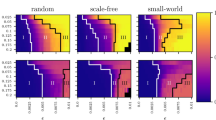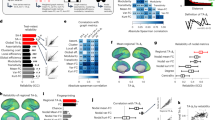Abstract
Many natural systems can be described as networks of interacting elements, forming a graph of interactions. This is the case for climate models, coupled chemical systems, computer or social networks, or the brain. For many of these cases, dynamical networks emerge whose structure changes in time. Estimating the structure of such networks from the time series that describe the activity of their nodes is a serious challenge. Here, we devise a new method that is based on the Scaled Correlation function to estimate interactions between nodes that occur on fast timescales. We apply the method on EEG measurements from human volunteers to evaluate neuronal functional connectivity associated with a visual perception task. We compare the statistics of networks extracted with the new method with those that are extracted using traditional techniques, like the Pearson correlation coefficient or the cross-correlation function. Results indicate that the new method is superior in identifying networks whose structure correlates to the cognitive processes engaged during visual perception. The method is general enough to be applied on any data that describes dynamical interactions evolving on multiple timescales, as is the case in climate modeling, chemical networks, or complex biological systems.
Access this chapter
Tax calculation will be finalised at checkout
Purchases are for personal use only
Similar content being viewed by others
References
Barabasi, A.L.: Network Science. Cambridge University Press, Cambridge (2016)
Koniaris, M., Anagnostopoulos, I., Vassiliou, Y.: Network analysis in the legal domain: a complex model for European Union legal sources, CoRR (2015)
Baggio, R., Scott, N., Cooper, C.: Network science: a review focused on tourism. Ann. Tour. Res. 37, 802–827 (2010)
Bullmore, E., Sporns, O.: Complex brain networks: graph theoretical analysis of structural and functional systems. Nat. Rev. Neurosci. 10(4), 312 (2009)
Lange, S., Donges, J.F., Volkholz, J., Kurths, J.: Local difference measures between complex networks for dynamical system model evaluation. PLoS ONE 10(4), e0129413 (2015)
Pearson, K.: Notes on regression and inheritance in the case of two parents. Proc. Royal Soc. Lond. 58, 240–242 (1895)
Bracewell, R.: Pentagram notation for cross correlation. In: The Fourier Transform and Its Applications, pp. 46 and 243. McGraw-Hill, New York (1965)
Nikolić, D., Mureşan, R.C., Feng, W., Singer, W.: Scaled correlation analysis: a better way to compute a cross-correlogram. Eur. J. Neurosci. 35(5), 742–762 (2012)
Friston, K.J.: Functional and effective connectivity: a review. Brain Connect. 1(1), 13–36 (2011)
Park, H.J., Friston, K.: Structural and functional brain networks: from connections to cognition. Science 342(6158), 1238411 (2013)
Rubinov, M., Sporns, O.: Complex network measures of brain connectivity: uses and interpretations. NeuroImage 52(3), 1059–1069 (2010). Computational Models of the Brain
Finc, K., Bonna, K., Lewandowska, M., Wolak, T., Nikadon, J., Dreszer, J., Duch, W., Khn, S.: Transition of the functional brain network related to increasing cognitive demands. Hum. Brain Mapp. 38, 3659–3674 (2017)
Joudaki, A., Salehi, N., Jalili, M., Knyazeva, M.G.: EEG based functional brain networks: does the network size matter? PLoS ONE 7(4), 1–9 (2012)
Jalili, M., Knyazeva, M.G.: Constructing brain functional networks from EEG: partial and unpartial correlations. J. Integr. Neurosci. 10(2), 213–232 (2011)
Meador, K.J., Ray, P.G.: Gamma frequency coherence and conscious perception. J. Clin. Neurophysiol. 16(2), 170 (1999)
Bordier, C., Nicolini, C., Bifone, A.: Graph analysis and modularity of brain functional connectivity networks: searching for the optimal threshold. Front. Neurosci. 11, 441 (2017)
Opsahl, T., Agneessens, F., Skvoretz, J.: Node centrality in weighted networks: generalizing degree and shortest paths. Soc. Netw. 32(3), 245–251 (2010)
Reppas, A.I., Spiliotis, K., Siettos, C.I.: Tuning the average path length of complex networks and its influence to the emergent dynamics of the majority-rule model. Math. Comput. Simul. 109, 186–196 (2015)
Opsahl, T., Panzarasa, P.: Clustering in weighted networks. Soci. Netw. 31(2), 155–163 (2009)
Moca, V.V., Ţincaş, I., Melloni, L., Mureşan, R.C.: Visual exploration and object recognition by lattice deformation. PLoS ONE 6(7), e22831 (2011)
Singer, W.: Neuronal synchrony: a versatile code for the definition of relations? Neuron 24(1), 49–65 (1999)
Fries, P., Nikolić, D., Singer, W.: The gamma cycle. Trends Neurosci. 30(7), 309–316 (2007)
Stam, C.J.: Modern network science of neurological disorders. Nat. Rev. Neurosci. 15, 683–695 (2014)
Jarosiewicz, B., Chase, S.M., Fraser, G.W., Velliste, M., Kass, R.E., Schwartz, A.B.: Functional network reorganization during learning in a brain-computer interface paradigm. Proc. Natl. Acad. Sci. U.S.A. 105(49), 19486–19491 (2008)
Acknowledgement
This work was supported by two grants from Consiliul National al Cercetării Ştiinţifice (CNCS) - Unitatea Executivă pentru Finanţarea Învăţământului Superior, a Cercetării Dezvoltării şi Inovării (UEFISCDI): PNII-RU-TE-2014-4- 13 0406/2015 contract no. 169/2015 and PN-III-P4-ID-PCE-2016-0010 contract no. 78/2017.
Author information
Authors and Affiliations
Corresponding author
Editor information
Editors and Affiliations
Rights and permissions
Copyright information
© 2018 Springer International Publishing AG, part of Springer Nature
About this paper
Cite this paper
Dolean, S., Dînşoreanu, M., Mureşan, R.C., Geiszt, A., Potolea, R., Ţincaş, I. (2018). A Scaled-Correlation Based Approach for Defining and Analyzing Functional Networks. In: Appice, A., Loglisci, C., Manco, G., Masciari, E., Ras, Z. (eds) New Frontiers in Mining Complex Patterns. NFMCP 2017. Lecture Notes in Computer Science(), vol 10785. Springer, Cham. https://doi.org/10.1007/978-3-319-78680-3_6
Download citation
DOI: https://doi.org/10.1007/978-3-319-78680-3_6
Published:
Publisher Name: Springer, Cham
Print ISBN: 978-3-319-78679-7
Online ISBN: 978-3-319-78680-3
eBook Packages: Computer ScienceComputer Science (R0)




